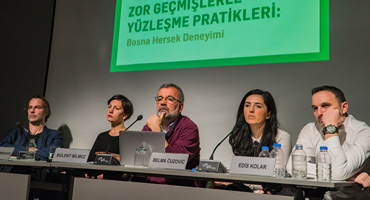Within the framework of the panel series on sites of memory, we organized our first event on June 10th 2016, at the Havak Hall of the Hrant Dink Foundation. Horst Hoheisel and Andreas Knitz from Germany participated as guest speakers to the panel entitled as ‘Places of Memory and Memory of the Places’. Mr. Hoheisel was born in Poznan, Poland and he lives and works in Kassel, Germany. He developed often together with architect Andreas Knitz new shapes of monuments, which became internationally known as “counter-memorials.” The TEAM Hoheisel & Knitz has participated in numerous exhibitions, art projects, and interventions and has designed counter memorials dealing with the usually tabooed topics of past dictatorships, social trauma and violent events in Germany, Austria, the U.S.A. and Latin America.
On June 2016, in the panel discussion titled 'Places of the Memory, Memories of Places', Horst Hoheisel and Andreas Knitz told about their work of memorialization and confronting the past by using the counter-monuments they designed in Germany and South America.

They explained in detail, the memorials that they built and the memorialization projects that they implemented. Aschrott Fountain, Memorial to a Memorial, Grey Bus Monument were among the works that they presented. Aschrott Fountain replica by Hoheisel is one of the works they talked about in the panel discussion. German Jew Sigmund Aschrott had the original fountain built in 1908 in Kassel city of Germany and it was destroyed by the Nazis on April 9, 1939. Hoheisel made a replica of the fountain in 1987 in order to make people remember the original one. He covered the replica with glass, turned it upside down and placed it underground in order to show the absence of the fountain and the destructiveness of Nazism. Another work they talked about was a “counter-monument to a monument” that was built in Buchenwald concentration camp right after the fall of Nazis for a commemoration ceremony. This counter-monument, which built in the place of the original monument that was demolished after a short while, featured the names of the countries from where European Jews were and its temperature was set to 37 °C, which is human body temperature. Among all the many works presented during the panel, they also talked about the grey bus monument that was built to commemorate the psychiatric patients who fell victim to euthanasia practice of Nazis. This monument, which symbolizes the grey buses that led to patients to their demise, is the first moving monument in the world.
Moderated by the director of Memory Center Murat Çelikkan, the presentation emphasized the importance of showing the presence of absence and featured tens of images and videos. Hoheisel and Knitz answered the questions of the participants at the end of the panel discussion, in which around 110 people attended.




